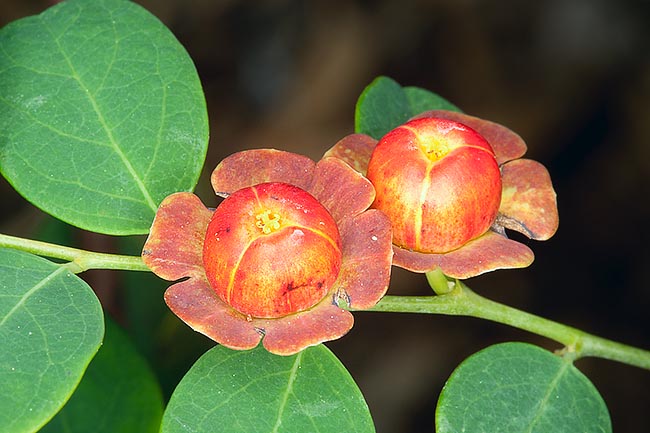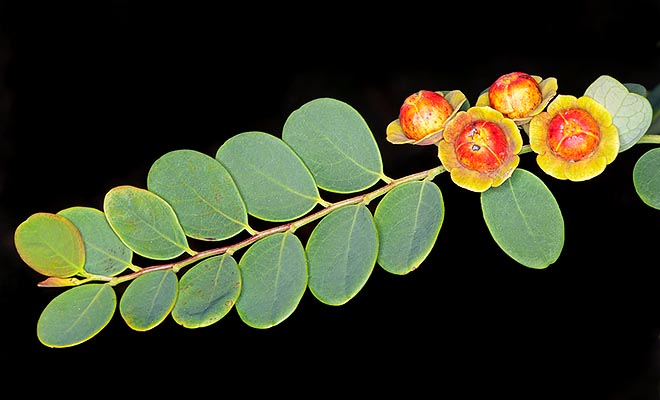Family : Phyllanthaceae

Text © Pietro Puccio

English translation by Mario Beltramini

Breynia retusa fruits are 0,5-0,8 cm globose three-cells berries © Giuseppe Mazza
The genus is honoured to the German physician and naturalist Johann Philipp Breyn (1680-1764); the name of the species is the Latin adjective “retusus, a, um” = obtuse, blunt, with reference to the rounded apex of the leaves.
Common names: cupped coral-berry tree, cup-saucer plant (English); chitki (Bengali); dun ye hei mian shen (Chinese); bois de corbeau, mourongue marron, péteuse, ti-pomme (French); kamboi (Gujarati); retund, kangli (Hindi); dalfodi, tikali (Marathi), sano nun dhiki (Nepali).
The Breynia retusa (Dennst.) Alston (1929) is an erect shrub, 0,5-3,5 m tall, with the bark brown coloured in the lignified part, expanded thin branches and simple alternate leaves, placed horizontally on the same plane (distichous), entire, ovate or elliptic, on short petiole, 1,3-3 cm long and 0,7-2 cm broad, dark green on the upper page, pale green below.
Unisexual flowers without petals, the male ones, solitary or in groups of 2-3 at the axil of the lower leaves, on a 0,2-0,5 cm long peduncle, hanging with campanulate calyx with 6 lobes, of about 0,3 cm of diameter, of pale yellow colour, and three stamina.

The plant, a small shrub, is at very high extinction risk in the wild © Giuseppe Mazza
The fruits are globose berries of 0,5-0,8 cm of diameter, with fleshy exocarp, of bright red colour tending to brown when ripe, with three cells containing each one two trigone seeds, about 0,4 cm long, of colour from yellow to red. It reproduces by seed in sandy soil kept humid at the temperature of 22-24 °C.
Rarely cultivated species outside from the origin zones, which draws the attention due to the small fruits with particular shape, cultivable in the tropical, subtropical and marginally warm temperate climate zones, in full sun or slight shade; it is not particular for what the soil is concerned, provided the same is draining. Roots and leaves are utilized in the traditional medicine for various pathologies.
The species is reported into the red list of the IUCN (International Union for the Conservation of Nature and Natural Resources) as “Critically Endangered” (at extremely high risk of extinction in the wild in the immediate future).
Synonyms: Phyllanthus retusus Dennst. (1818); Phyllanthus pomaceus Moon (1824); Phyllanthus patens Roxb. (1832); Phyllanthus turbinatus J.König ex Roxb. (1832); Melanthesa retusa (Dennst.) Kostel. (1836); Melanthesa turbinata Oken (1841); Melanthesa turbinata Oken (1841); Flueggea retusa (Dennst.) Voigt (1845); Phyllanthus suffultus Wall. (1847); Melanthesa obliqua Wight (1852); Melanthesopsis variabilis Müll.Arg. (1863); Phyllanthus naviluri Miq. ex Müll.Arg. (1863); Melanthesopsis patens (Roxb.) Müll.Arg. (1866); Breynia patens (Roxb.) Rolfe (1882); Breynia patens (Roxb.) Benth. & Hook. f. (1883); Breynia angustifolia Hook.f. (1887); Breynia turbinata (Oken) Cordem. (1895); Sauropus elegantissimus Ridl. (1926); Breynia hyposauropus Croizat (1940).
→ To appreciate the biodiversity within PHYLLANTHACEAE family please click here.
